Marketing Strategies of Woolworths Supermarket: A Detailed Report
VerifiedAdded on 2023/04/21
|8
|2187
|485
Report
AI Summary
This report provides a comprehensive analysis of the marketing strategies employed by Woolworths supermarket, a major retail chain in Australia and New Zealand. It delves into Woolworths' target market strategy, examining its socio-economic and psychographic profiles, as well as consumer purchasing behavior. The report then explores market segmentation, focusing on demographic segmentation based on age, gender, income, and education levels. Furthermore, it examines the application of consumer behavior concepts in store layout, including product offerings, pricing strategies, place (store locations and online presence), promotional activities, people (employee management), processes, and physical evidence. The report concludes by emphasizing the importance of these marketing strategies in achieving competitive advantage and market dominance within the retail industry.
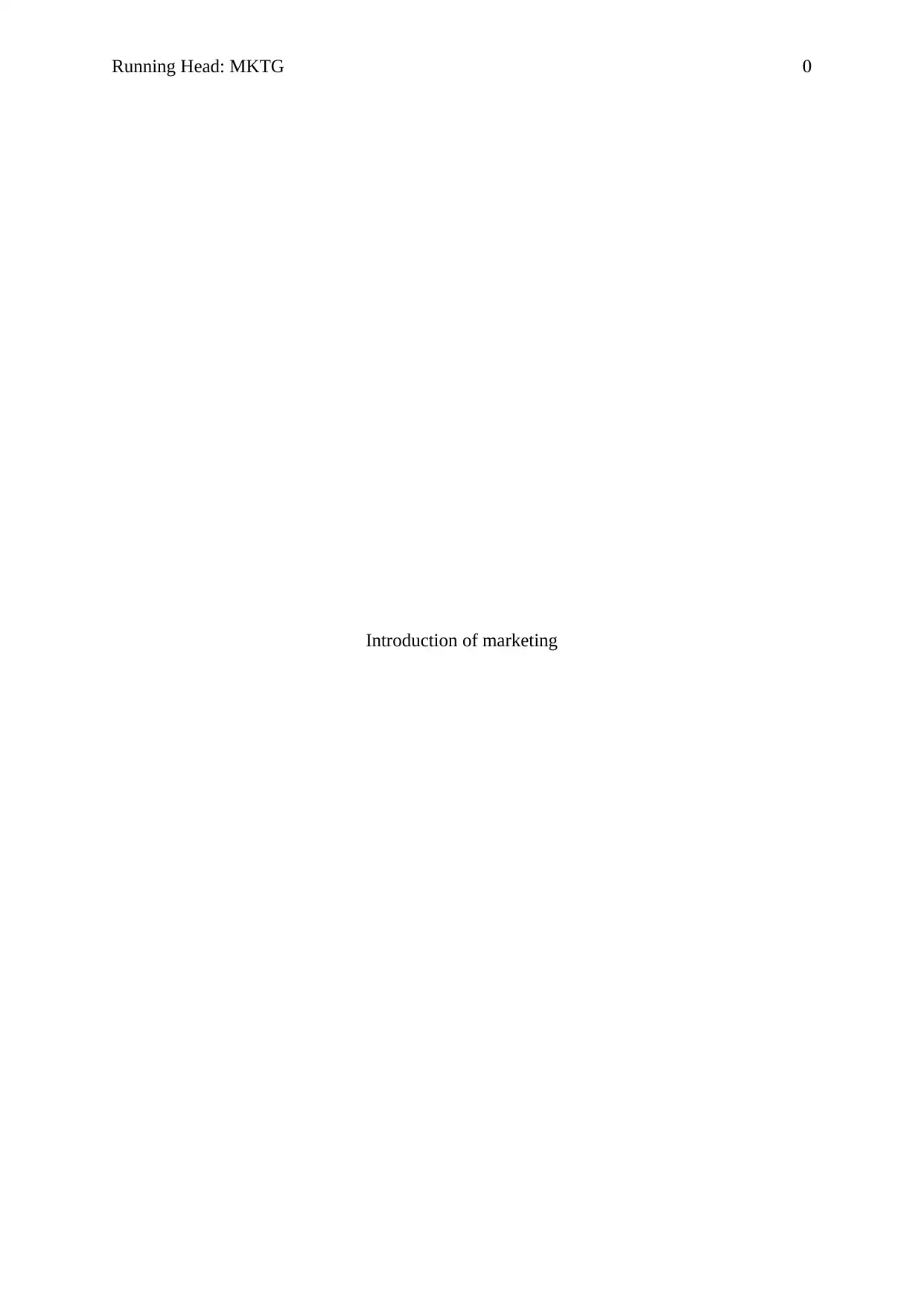
Running Head: MKTG 0
Introduction of marketing
Introduction of marketing
Paraphrase This Document
Need a fresh take? Get an instant paraphrase of this document with our AI Paraphraser
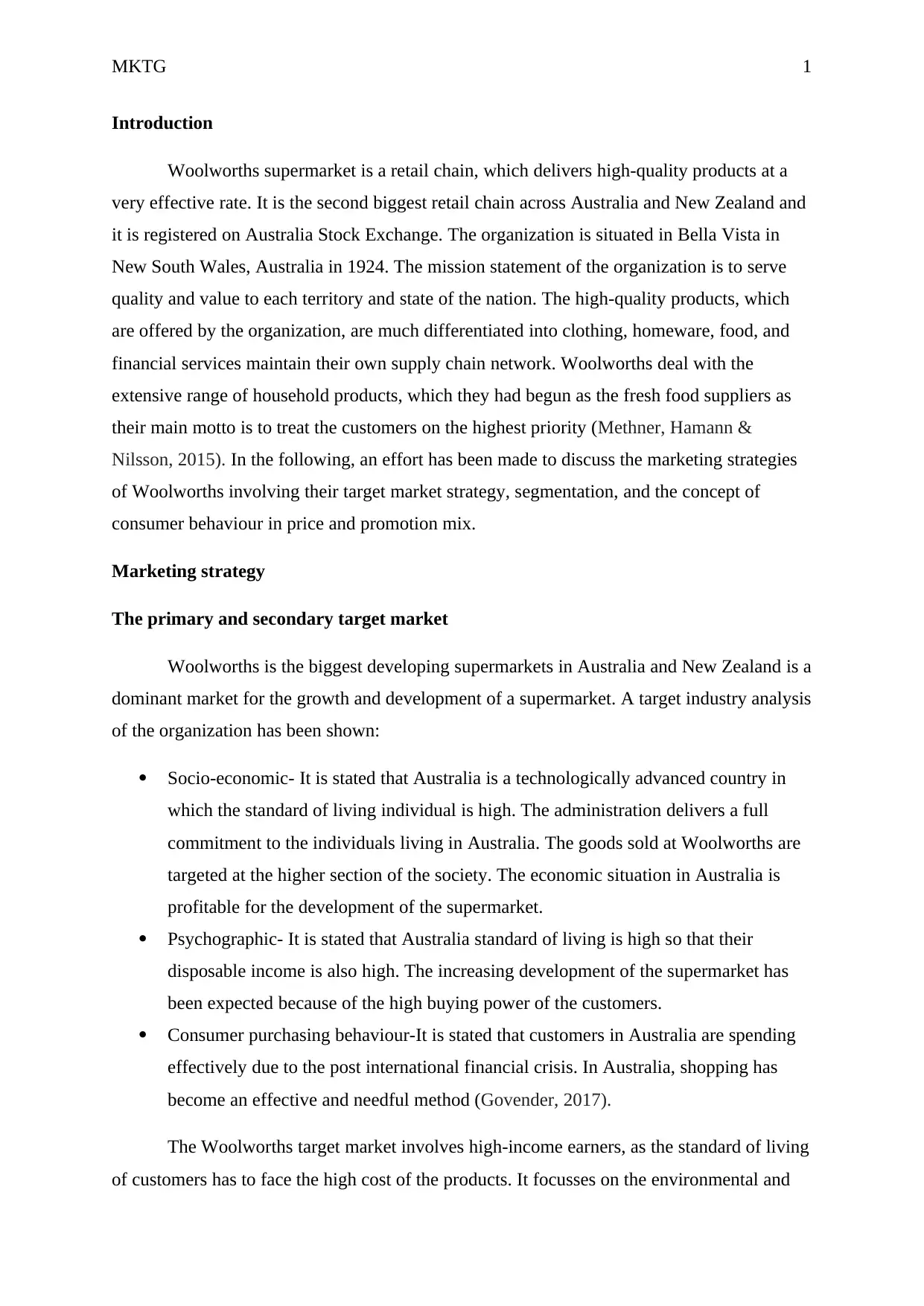
MKTG 1
Introduction
Woolworths supermarket is a retail chain, which delivers high-quality products at a
very effective rate. It is the second biggest retail chain across Australia and New Zealand and
it is registered on Australia Stock Exchange. The organization is situated in Bella Vista in
New South Wales, Australia in 1924. The mission statement of the organization is to serve
quality and value to each territory and state of the nation. The high-quality products, which
are offered by the organization, are much differentiated into clothing, homeware, food, and
financial services maintain their own supply chain network. Woolworths deal with the
extensive range of household products, which they had begun as the fresh food suppliers as
their main motto is to treat the customers on the highest priority (Methner, Hamann &
Nilsson, 2015). In the following, an effort has been made to discuss the marketing strategies
of Woolworths involving their target market strategy, segmentation, and the concept of
consumer behaviour in price and promotion mix.
Marketing strategy
The primary and secondary target market
Woolworths is the biggest developing supermarkets in Australia and New Zealand is a
dominant market for the growth and development of a supermarket. A target industry analysis
of the organization has been shown:
Socio-economic- It is stated that Australia is a technologically advanced country in
which the standard of living individual is high. The administration delivers a full
commitment to the individuals living in Australia. The goods sold at Woolworths are
targeted at the higher section of the society. The economic situation in Australia is
profitable for the development of the supermarket.
Psychographic- It is stated that Australia standard of living is high so that their
disposable income is also high. The increasing development of the supermarket has
been expected because of the high buying power of the customers.
Consumer purchasing behaviour-It is stated that customers in Australia are spending
effectively due to the post international financial crisis. In Australia, shopping has
become an effective and needful method (Govender, 2017).
The Woolworths target market involves high-income earners, as the standard of living
of customers has to face the high cost of the products. It focusses on the environmental and
Introduction
Woolworths supermarket is a retail chain, which delivers high-quality products at a
very effective rate. It is the second biggest retail chain across Australia and New Zealand and
it is registered on Australia Stock Exchange. The organization is situated in Bella Vista in
New South Wales, Australia in 1924. The mission statement of the organization is to serve
quality and value to each territory and state of the nation. The high-quality products, which
are offered by the organization, are much differentiated into clothing, homeware, food, and
financial services maintain their own supply chain network. Woolworths deal with the
extensive range of household products, which they had begun as the fresh food suppliers as
their main motto is to treat the customers on the highest priority (Methner, Hamann &
Nilsson, 2015). In the following, an effort has been made to discuss the marketing strategies
of Woolworths involving their target market strategy, segmentation, and the concept of
consumer behaviour in price and promotion mix.
Marketing strategy
The primary and secondary target market
Woolworths is the biggest developing supermarkets in Australia and New Zealand is a
dominant market for the growth and development of a supermarket. A target industry analysis
of the organization has been shown:
Socio-economic- It is stated that Australia is a technologically advanced country in
which the standard of living individual is high. The administration delivers a full
commitment to the individuals living in Australia. The goods sold at Woolworths are
targeted at the higher section of the society. The economic situation in Australia is
profitable for the development of the supermarket.
Psychographic- It is stated that Australia standard of living is high so that their
disposable income is also high. The increasing development of the supermarket has
been expected because of the high buying power of the customers.
Consumer purchasing behaviour-It is stated that customers in Australia are spending
effectively due to the post international financial crisis. In Australia, shopping has
become an effective and needful method (Govender, 2017).
The Woolworths target market involves high-income earners, as the standard of living
of customers has to face the high cost of the products. It focusses on the environmental and
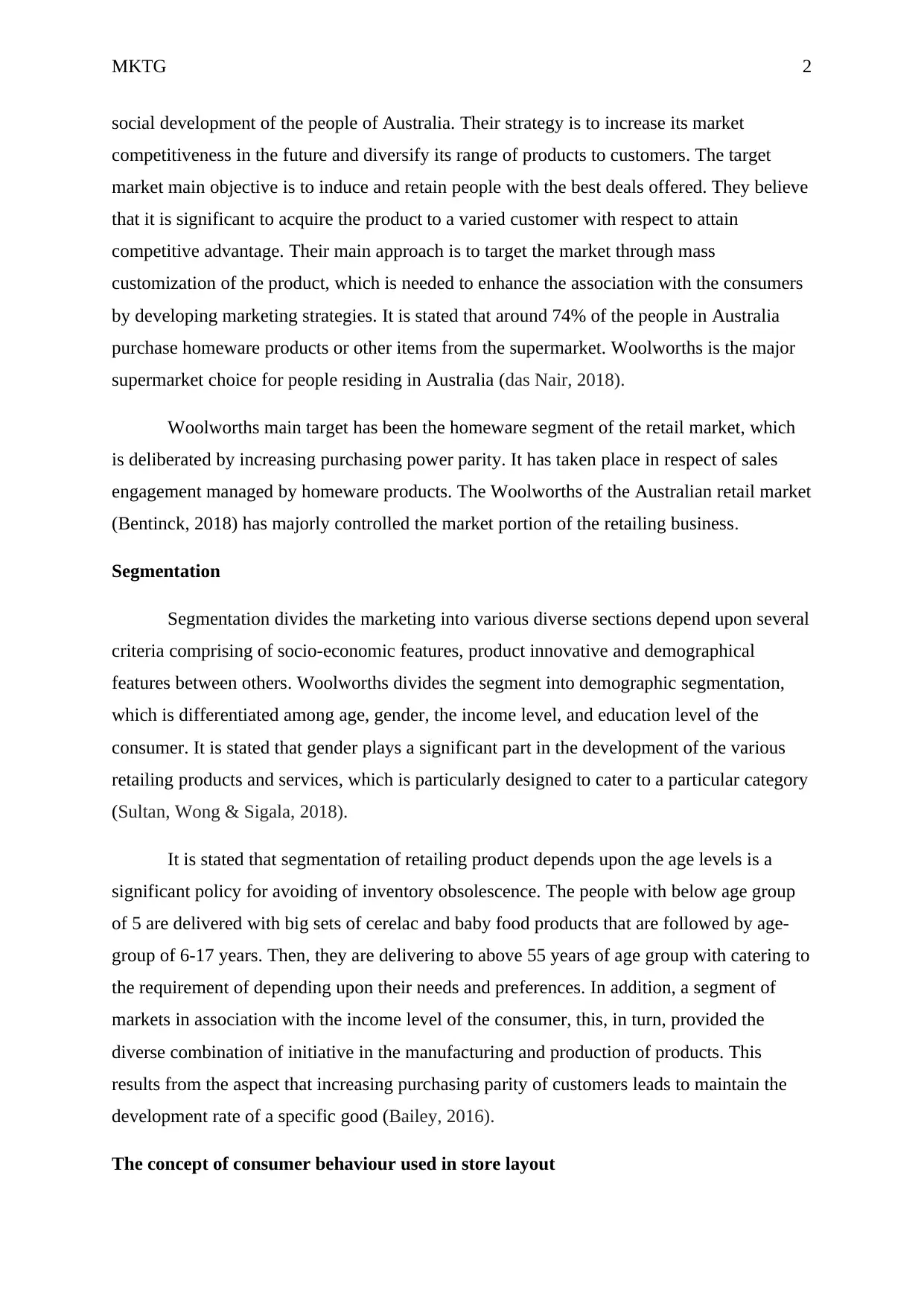
MKTG 2
social development of the people of Australia. Their strategy is to increase its market
competitiveness in the future and diversify its range of products to customers. The target
market main objective is to induce and retain people with the best deals offered. They believe
that it is significant to acquire the product to a varied customer with respect to attain
competitive advantage. Their main approach is to target the market through mass
customization of the product, which is needed to enhance the association with the consumers
by developing marketing strategies. It is stated that around 74% of the people in Australia
purchase homeware products or other items from the supermarket. Woolworths is the major
supermarket choice for people residing in Australia (das Nair, 2018).
Woolworths main target has been the homeware segment of the retail market, which
is deliberated by increasing purchasing power parity. It has taken place in respect of sales
engagement managed by homeware products. The Woolworths of the Australian retail market
(Bentinck, 2018) has majorly controlled the market portion of the retailing business.
Segmentation
Segmentation divides the marketing into various diverse sections depend upon several
criteria comprising of socio-economic features, product innovative and demographical
features between others. Woolworths divides the segment into demographic segmentation,
which is differentiated among age, gender, the income level, and education level of the
consumer. It is stated that gender plays a significant part in the development of the various
retailing products and services, which is particularly designed to cater to a particular category
(Sultan, Wong & Sigala, 2018).
It is stated that segmentation of retailing product depends upon the age levels is a
significant policy for avoiding of inventory obsolescence. The people with below age group
of 5 are delivered with big sets of cerelac and baby food products that are followed by age-
group of 6-17 years. Then, they are delivering to above 55 years of age group with catering to
the requirement of depending upon their needs and preferences. In addition, a segment of
markets in association with the income level of the consumer, this, in turn, provided the
diverse combination of initiative in the manufacturing and production of products. This
results from the aspect that increasing purchasing parity of customers leads to maintain the
development rate of a specific good (Bailey, 2016).
The concept of consumer behaviour used in store layout
social development of the people of Australia. Their strategy is to increase its market
competitiveness in the future and diversify its range of products to customers. The target
market main objective is to induce and retain people with the best deals offered. They believe
that it is significant to acquire the product to a varied customer with respect to attain
competitive advantage. Their main approach is to target the market through mass
customization of the product, which is needed to enhance the association with the consumers
by developing marketing strategies. It is stated that around 74% of the people in Australia
purchase homeware products or other items from the supermarket. Woolworths is the major
supermarket choice for people residing in Australia (das Nair, 2018).
Woolworths main target has been the homeware segment of the retail market, which
is deliberated by increasing purchasing power parity. It has taken place in respect of sales
engagement managed by homeware products. The Woolworths of the Australian retail market
(Bentinck, 2018) has majorly controlled the market portion of the retailing business.
Segmentation
Segmentation divides the marketing into various diverse sections depend upon several
criteria comprising of socio-economic features, product innovative and demographical
features between others. Woolworths divides the segment into demographic segmentation,
which is differentiated among age, gender, the income level, and education level of the
consumer. It is stated that gender plays a significant part in the development of the various
retailing products and services, which is particularly designed to cater to a particular category
(Sultan, Wong & Sigala, 2018).
It is stated that segmentation of retailing product depends upon the age levels is a
significant policy for avoiding of inventory obsolescence. The people with below age group
of 5 are delivered with big sets of cerelac and baby food products that are followed by age-
group of 6-17 years. Then, they are delivering to above 55 years of age group with catering to
the requirement of depending upon their needs and preferences. In addition, a segment of
markets in association with the income level of the consumer, this, in turn, provided the
diverse combination of initiative in the manufacturing and production of products. This
results from the aspect that increasing purchasing parity of customers leads to maintain the
development rate of a specific good (Bailey, 2016).
The concept of consumer behaviour used in store layout
⊘ This is a preview!⊘
Do you want full access?
Subscribe today to unlock all pages.

Trusted by 1+ million students worldwide

MKTG 3
The concept of consumer behaviour used in store layout determines the pricing,
distribution, and promotion strategies used by the organization.
Product:
Woolworths is a dominant retailer of Australia, which delivers offers all types of
groceries and homeware items as a part of the store layout. They involve fruits, packaged,
meat, vegetable, and other products. Within each category, they offer a varied variety of
alternative associated with the brand, international cuisine, and local produce. This range of
products is approved and tested to encourage quality and value. They have a differentiated
range of products, which has assisted to fulfill the needs of the customers, which is a one-stop
solution for them (Rundle-Thiele, Dietrich & Kubacki, 2017).
Price:
Woolworths directed to maintain the prices at an effective rate in the industry. It also
delivers a varied variety of premium brands associated with the food chain in which prices
are sustained at a lower rate than competitors in the market. They also assist the customer
segment, which prefers premium prices. It is stated that shopper club at Tasmania stores
delivers $20 vouchers for every 2000 points. It also offers a Woolworths shopping card,
which tracks purchases and delivers discounts to the customers (Pulker, Scott & Pollard,
2018).
Place:
Woolworths presently operates 1000 store, in which 950+ are a supermarket and other
are convenience stores. They have private label brands as Woolworths Select, Woolworths
Fresh, Woolworths Homebrand, and Woolworths gold. They have also started operating
through an online platform as a mobile app for dealing with the customers. The retail chains
utilizing this name as a brand are located in the United Kingdom, Austria, Germany, and
Mexico. They also operate stores in South Africa such as Marks N Spencer, which has a wide
distribution network (Johnston, Stafford, Pierce & Daube, 2017).
Promotion:
In Woolworths, promotion is of keen importance as they are continuously being innovating in
the same. They are delivering several loyalty schemes for consumers, which involve
discounts that assist in attracting and retaining for the same. They are utilizing online
The concept of consumer behaviour used in store layout determines the pricing,
distribution, and promotion strategies used by the organization.
Product:
Woolworths is a dominant retailer of Australia, which delivers offers all types of
groceries and homeware items as a part of the store layout. They involve fruits, packaged,
meat, vegetable, and other products. Within each category, they offer a varied variety of
alternative associated with the brand, international cuisine, and local produce. This range of
products is approved and tested to encourage quality and value. They have a differentiated
range of products, which has assisted to fulfill the needs of the customers, which is a one-stop
solution for them (Rundle-Thiele, Dietrich & Kubacki, 2017).
Price:
Woolworths directed to maintain the prices at an effective rate in the industry. It also
delivers a varied variety of premium brands associated with the food chain in which prices
are sustained at a lower rate than competitors in the market. They also assist the customer
segment, which prefers premium prices. It is stated that shopper club at Tasmania stores
delivers $20 vouchers for every 2000 points. It also offers a Woolworths shopping card,
which tracks purchases and delivers discounts to the customers (Pulker, Scott & Pollard,
2018).
Place:
Woolworths presently operates 1000 store, in which 950+ are a supermarket and other
are convenience stores. They have private label brands as Woolworths Select, Woolworths
Fresh, Woolworths Homebrand, and Woolworths gold. They have also started operating
through an online platform as a mobile app for dealing with the customers. The retail chains
utilizing this name as a brand are located in the United Kingdom, Austria, Germany, and
Mexico. They also operate stores in South Africa such as Marks N Spencer, which has a wide
distribution network (Johnston, Stafford, Pierce & Daube, 2017).
Promotion:
In Woolworths, promotion is of keen importance as they are continuously being innovating in
the same. They are delivering several loyalty schemes for consumers, which involve
discounts that assist in attracting and retaining for the same. They are utilizing online
Paraphrase This Document
Need a fresh take? Get an instant paraphrase of this document with our AI Paraphraser
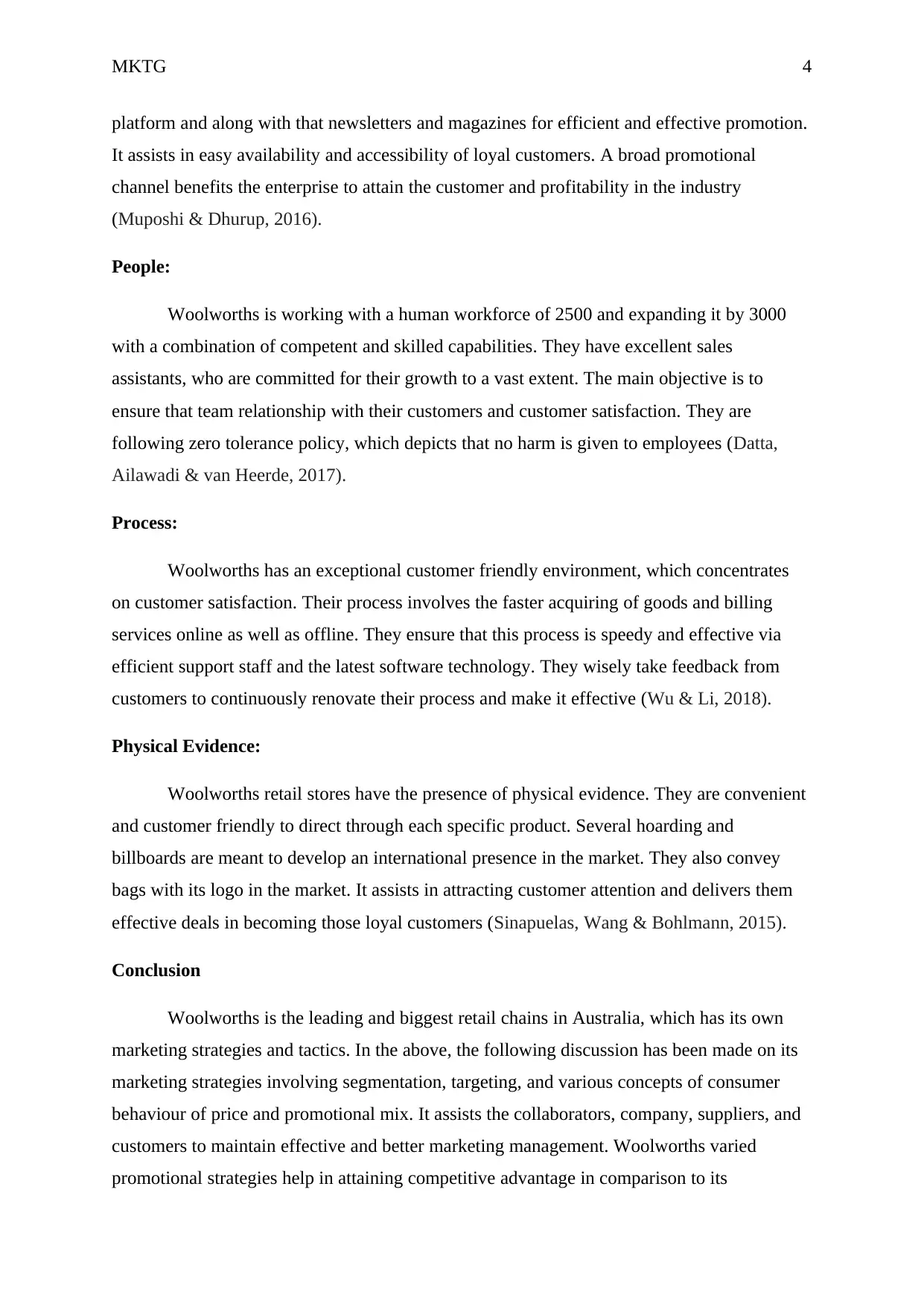
MKTG 4
platform and along with that newsletters and magazines for efficient and effective promotion.
It assists in easy availability and accessibility of loyal customers. A broad promotional
channel benefits the enterprise to attain the customer and profitability in the industry
(Muposhi & Dhurup, 2016).
People:
Woolworths is working with a human workforce of 2500 and expanding it by 3000
with a combination of competent and skilled capabilities. They have excellent sales
assistants, who are committed for their growth to a vast extent. The main objective is to
ensure that team relationship with their customers and customer satisfaction. They are
following zero tolerance policy, which depicts that no harm is given to employees (Datta,
Ailawadi & van Heerde, 2017).
Process:
Woolworths has an exceptional customer friendly environment, which concentrates
on customer satisfaction. Their process involves the faster acquiring of goods and billing
services online as well as offline. They ensure that this process is speedy and effective via
efficient support staff and the latest software technology. They wisely take feedback from
customers to continuously renovate their process and make it effective (Wu & Li, 2018).
Physical Evidence:
Woolworths retail stores have the presence of physical evidence. They are convenient
and customer friendly to direct through each specific product. Several hoarding and
billboards are meant to develop an international presence in the market. They also convey
bags with its logo in the market. It assists in attracting customer attention and delivers them
effective deals in becoming those loyal customers (Sinapuelas, Wang & Bohlmann, 2015).
Conclusion
Woolworths is the leading and biggest retail chains in Australia, which has its own
marketing strategies and tactics. In the above, the following discussion has been made on its
marketing strategies involving segmentation, targeting, and various concepts of consumer
behaviour of price and promotional mix. It assists the collaborators, company, suppliers, and
customers to maintain effective and better marketing management. Woolworths varied
promotional strategies help in attaining competitive advantage in comparison to its
platform and along with that newsletters and magazines for efficient and effective promotion.
It assists in easy availability and accessibility of loyal customers. A broad promotional
channel benefits the enterprise to attain the customer and profitability in the industry
(Muposhi & Dhurup, 2016).
People:
Woolworths is working with a human workforce of 2500 and expanding it by 3000
with a combination of competent and skilled capabilities. They have excellent sales
assistants, who are committed for their growth to a vast extent. The main objective is to
ensure that team relationship with their customers and customer satisfaction. They are
following zero tolerance policy, which depicts that no harm is given to employees (Datta,
Ailawadi & van Heerde, 2017).
Process:
Woolworths has an exceptional customer friendly environment, which concentrates
on customer satisfaction. Their process involves the faster acquiring of goods and billing
services online as well as offline. They ensure that this process is speedy and effective via
efficient support staff and the latest software technology. They wisely take feedback from
customers to continuously renovate their process and make it effective (Wu & Li, 2018).
Physical Evidence:
Woolworths retail stores have the presence of physical evidence. They are convenient
and customer friendly to direct through each specific product. Several hoarding and
billboards are meant to develop an international presence in the market. They also convey
bags with its logo in the market. It assists in attracting customer attention and delivers them
effective deals in becoming those loyal customers (Sinapuelas, Wang & Bohlmann, 2015).
Conclusion
Woolworths is the leading and biggest retail chains in Australia, which has its own
marketing strategies and tactics. In the above, the following discussion has been made on its
marketing strategies involving segmentation, targeting, and various concepts of consumer
behaviour of price and promotional mix. It assists the collaborators, company, suppliers, and
customers to maintain effective and better marketing management. Woolworths varied
promotional strategies help in attaining competitive advantage in comparison to its
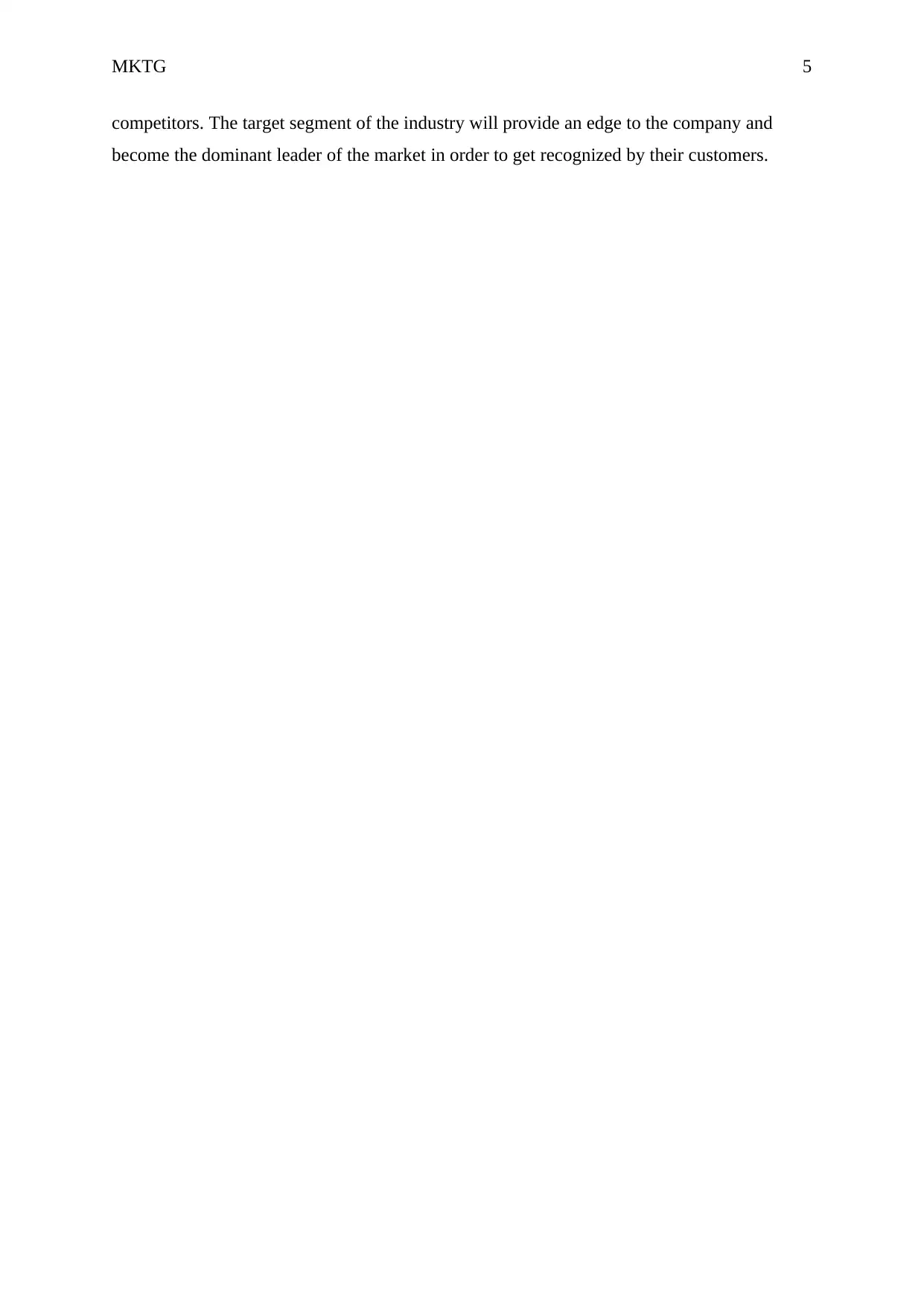
MKTG 5
competitors. The target segment of the industry will provide an edge to the company and
become the dominant leader of the market in order to get recognized by their customers.
competitors. The target segment of the industry will provide an edge to the company and
become the dominant leader of the market in order to get recognized by their customers.
⊘ This is a preview!⊘
Do you want full access?
Subscribe today to unlock all pages.

Trusted by 1+ million students worldwide
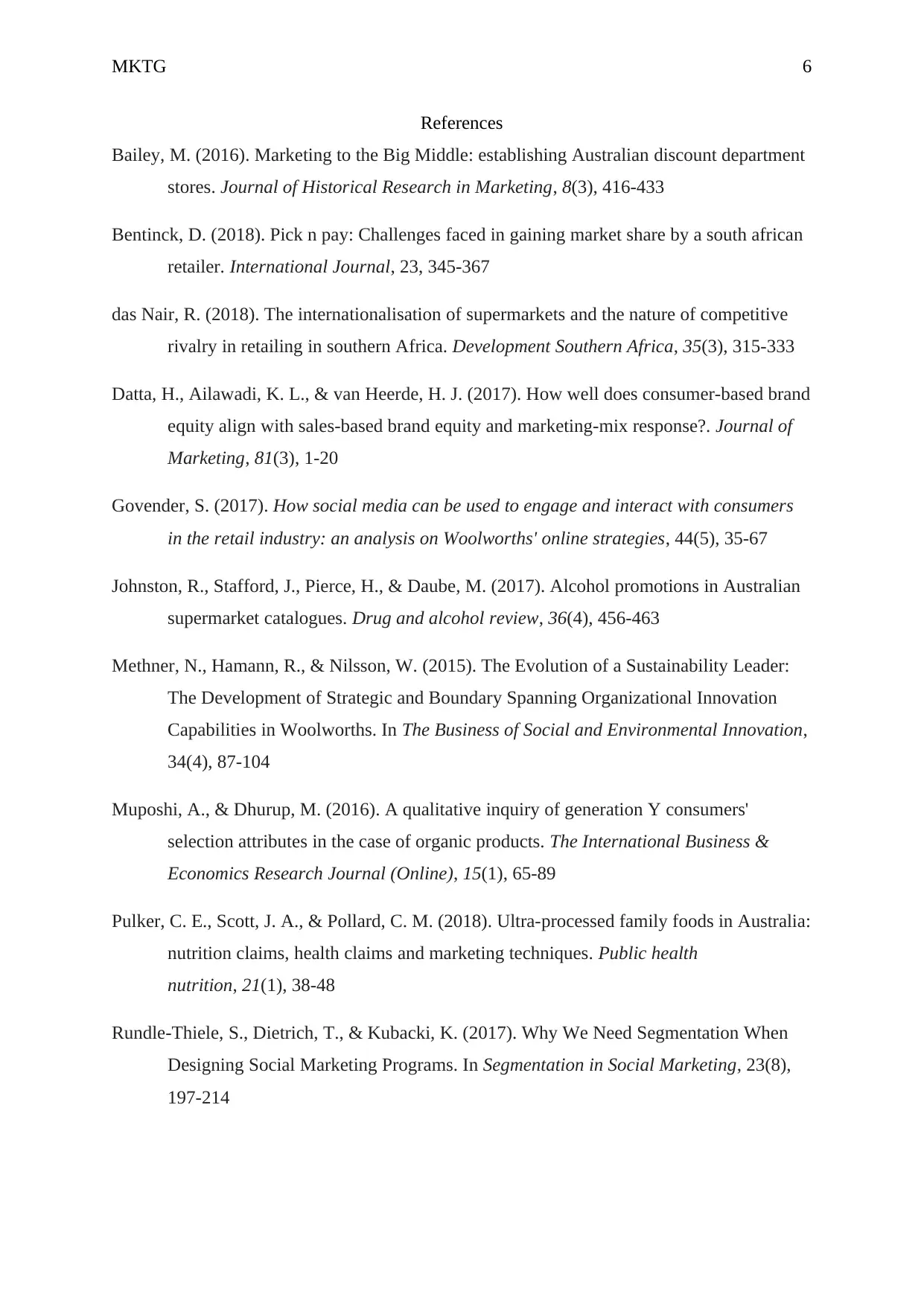
MKTG 6
References
Bailey, M. (2016). Marketing to the Big Middle: establishing Australian discount department
stores. Journal of Historical Research in Marketing, 8(3), 416-433
Bentinck, D. (2018). Pick n pay: Challenges faced in gaining market share by a south african
retailer. International Journal, 23, 345-367
das Nair, R. (2018). The internationalisation of supermarkets and the nature of competitive
rivalry in retailing in southern Africa. Development Southern Africa, 35(3), 315-333
Datta, H., Ailawadi, K. L., & van Heerde, H. J. (2017). How well does consumer-based brand
equity align with sales-based brand equity and marketing-mix response?. Journal of
Marketing, 81(3), 1-20
Govender, S. (2017). How social media can be used to engage and interact with consumers
in the retail industry: an analysis on Woolworths' online strategies, 44(5), 35-67
Johnston, R., Stafford, J., Pierce, H., & Daube, M. (2017). Alcohol promotions in Australian
supermarket catalogues. Drug and alcohol review, 36(4), 456-463
Methner, N., Hamann, R., & Nilsson, W. (2015). The Evolution of a Sustainability Leader:
The Development of Strategic and Boundary Spanning Organizational Innovation
Capabilities in Woolworths. In The Business of Social and Environmental Innovation,
34(4), 87-104
Muposhi, A., & Dhurup, M. (2016). A qualitative inquiry of generation Y consumers'
selection attributes in the case of organic products. The International Business &
Economics Research Journal (Online), 15(1), 65-89
Pulker, C. E., Scott, J. A., & Pollard, C. M. (2018). Ultra-processed family foods in Australia:
nutrition claims, health claims and marketing techniques. Public health
nutrition, 21(1), 38-48
Rundle-Thiele, S., Dietrich, T., & Kubacki, K. (2017). Why We Need Segmentation When
Designing Social Marketing Programs. In Segmentation in Social Marketing, 23(8),
197-214
References
Bailey, M. (2016). Marketing to the Big Middle: establishing Australian discount department
stores. Journal of Historical Research in Marketing, 8(3), 416-433
Bentinck, D. (2018). Pick n pay: Challenges faced in gaining market share by a south african
retailer. International Journal, 23, 345-367
das Nair, R. (2018). The internationalisation of supermarkets and the nature of competitive
rivalry in retailing in southern Africa. Development Southern Africa, 35(3), 315-333
Datta, H., Ailawadi, K. L., & van Heerde, H. J. (2017). How well does consumer-based brand
equity align with sales-based brand equity and marketing-mix response?. Journal of
Marketing, 81(3), 1-20
Govender, S. (2017). How social media can be used to engage and interact with consumers
in the retail industry: an analysis on Woolworths' online strategies, 44(5), 35-67
Johnston, R., Stafford, J., Pierce, H., & Daube, M. (2017). Alcohol promotions in Australian
supermarket catalogues. Drug and alcohol review, 36(4), 456-463
Methner, N., Hamann, R., & Nilsson, W. (2015). The Evolution of a Sustainability Leader:
The Development of Strategic and Boundary Spanning Organizational Innovation
Capabilities in Woolworths. In The Business of Social and Environmental Innovation,
34(4), 87-104
Muposhi, A., & Dhurup, M. (2016). A qualitative inquiry of generation Y consumers'
selection attributes in the case of organic products. The International Business &
Economics Research Journal (Online), 15(1), 65-89
Pulker, C. E., Scott, J. A., & Pollard, C. M. (2018). Ultra-processed family foods in Australia:
nutrition claims, health claims and marketing techniques. Public health
nutrition, 21(1), 38-48
Rundle-Thiele, S., Dietrich, T., & Kubacki, K. (2017). Why We Need Segmentation When
Designing Social Marketing Programs. In Segmentation in Social Marketing, 23(8),
197-214
Paraphrase This Document
Need a fresh take? Get an instant paraphrase of this document with our AI Paraphraser
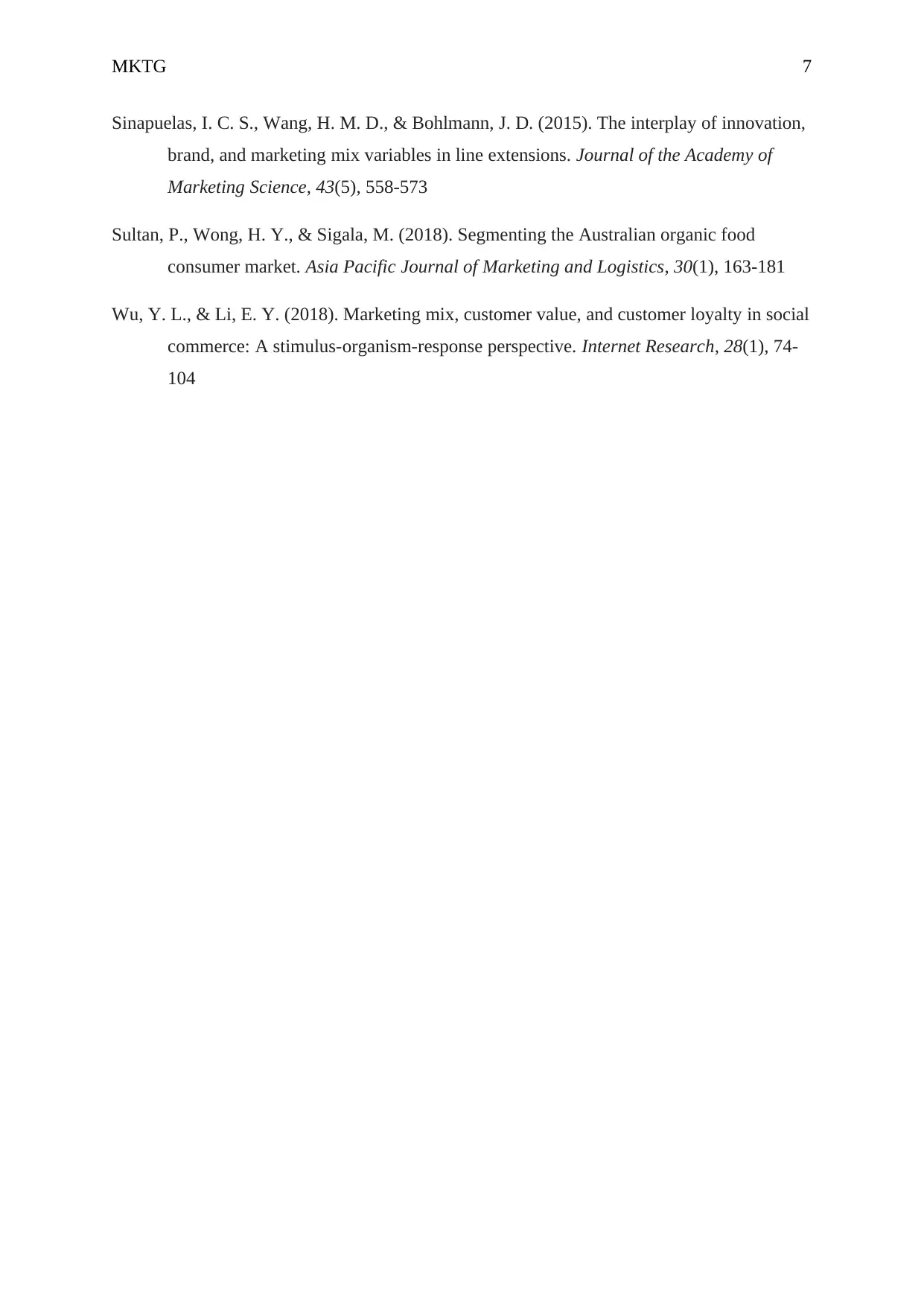
MKTG 7
Sinapuelas, I. C. S., Wang, H. M. D., & Bohlmann, J. D. (2015). The interplay of innovation,
brand, and marketing mix variables in line extensions. Journal of the Academy of
Marketing Science, 43(5), 558-573
Sultan, P., Wong, H. Y., & Sigala, M. (2018). Segmenting the Australian organic food
consumer market. Asia Pacific Journal of Marketing and Logistics, 30(1), 163-181
Wu, Y. L., & Li, E. Y. (2018). Marketing mix, customer value, and customer loyalty in social
commerce: A stimulus-organism-response perspective. Internet Research, 28(1), 74-
104
Sinapuelas, I. C. S., Wang, H. M. D., & Bohlmann, J. D. (2015). The interplay of innovation,
brand, and marketing mix variables in line extensions. Journal of the Academy of
Marketing Science, 43(5), 558-573
Sultan, P., Wong, H. Y., & Sigala, M. (2018). Segmenting the Australian organic food
consumer market. Asia Pacific Journal of Marketing and Logistics, 30(1), 163-181
Wu, Y. L., & Li, E. Y. (2018). Marketing mix, customer value, and customer loyalty in social
commerce: A stimulus-organism-response perspective. Internet Research, 28(1), 74-
104
1 out of 8
Related Documents
Your All-in-One AI-Powered Toolkit for Academic Success.
+13062052269
info@desklib.com
Available 24*7 on WhatsApp / Email
![[object Object]](/_next/static/media/star-bottom.7253800d.svg)
Unlock your academic potential
Copyright © 2020–2025 A2Z Services. All Rights Reserved. Developed and managed by ZUCOL.




